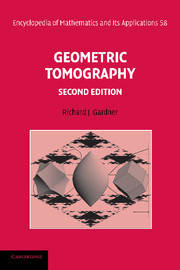Book contents
- Frontmatter
- Contents
- Preface to the second edition
- Preface
- 0 Background material
- 1 Parallel X-rays of planar convex bodies
- 2 Parallel X-rays in n dimensions
- 3 Projections and projection functions
- 4 Projection bodies and volume inequalities
- 5 Point X-rays
- 6 Chord functions and equichordal problems
- 7 Sections, section functions, and point X-rays
- 8 Intersection bodies and volume inequalities
- 9 Estimates from projection and section functions
- Appendixes
- References
- Notation
- Author index
- Subject index
3 - Projections and projection functions
Published online by Cambridge University Press: 05 June 2013
- Frontmatter
- Contents
- Preface to the second edition
- Preface
- 0 Background material
- 1 Parallel X-rays of planar convex bodies
- 2 Parallel X-rays in n dimensions
- 3 Projections and projection functions
- 4 Projection bodies and volume inequalities
- 5 Point X-rays
- 6 Chord functions and equichordal problems
- 7 Sections, section functions, and point X-rays
- 8 Intersection bodies and volume inequalities
- 9 Estimates from projection and section functions
- Appendixes
- References
- Notation
- Author index
- Subject index
Summary
What can one say about an object, given some information about its projections (shadows)? A substantial part of the classical theory of convexity has grown out of attempts to answer this question. In the first section of this chapter, the given information includes the shape of the shadows. For example, Theorem 3.1.3 implies that two compact convex sets in En, n ≥ 3, must be homothetic if their projections on any hyperplane are also homothetic, whereas Theorem 3.1.8 shows that “homothetic” cannot be replaced by “similar.” The width function is then introduced, followed by the more general projection functions. Such functions do not give the shape, but only the length, area, or volume, of the shadows. The latter yield surprisingly strong information, thanks to Aleksandrov's projection theorem, Theorem 3.3.6, implying that different centered convex bodies have different projection functions. However, the existence of certain special sets – the central symmetral, the Blaschke body, and sets of constant width and brightness – place limits on how much can be divined from projection functions.
The beautiful and powerful results in this chapter provide a convincing demonstration of the tools of the classical theory of convexity. The first of these is the support function. We suggest that the reader not familiar with this refer to Section 0.6 and ignore the proof of Theorem 3.1.8; Section 3.2 furnishes a gentle introduction to the support function at work.
Information
- Type
- Chapter
- Information
- Geometric Tomography , pp. 97 - 140Publisher: Cambridge University PressPrint publication year: 2006
